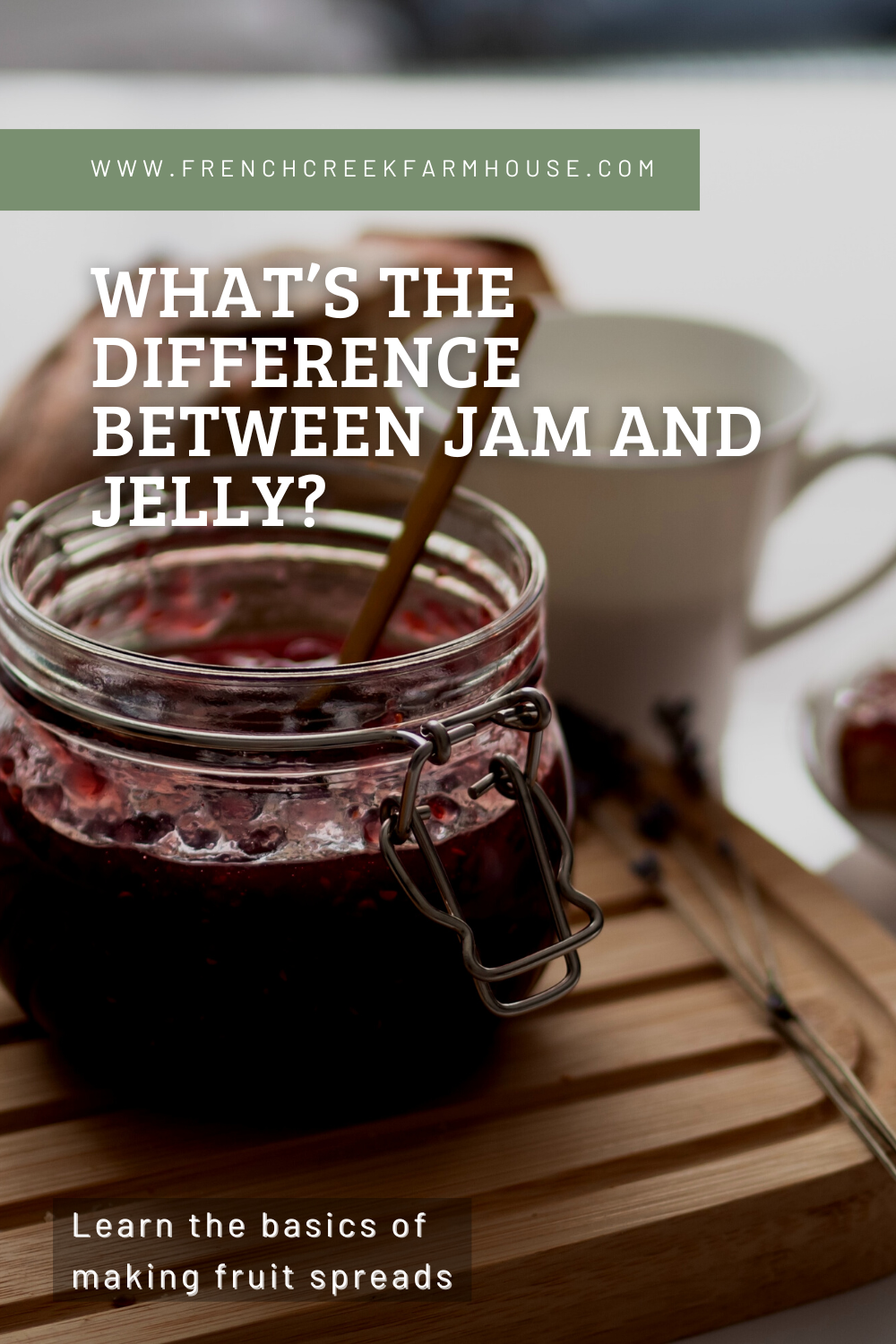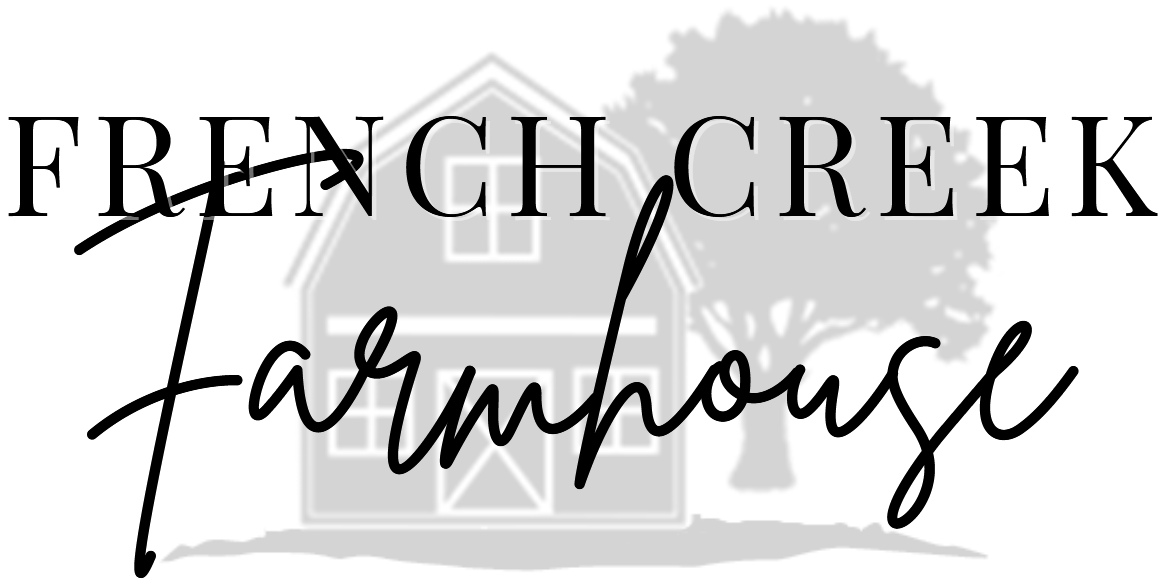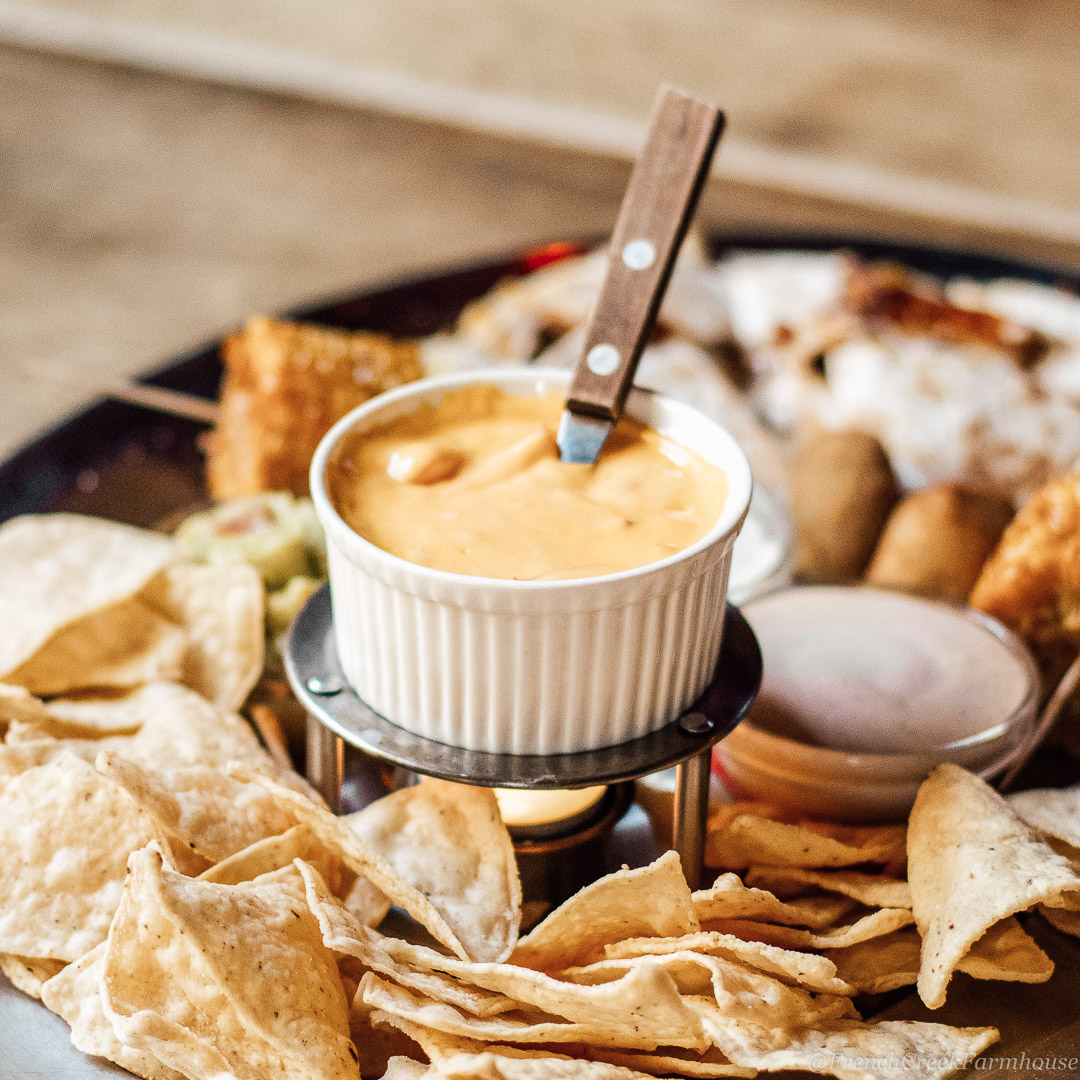The Difference Between Jam and Jelly (and Other Fruit Preserves!)
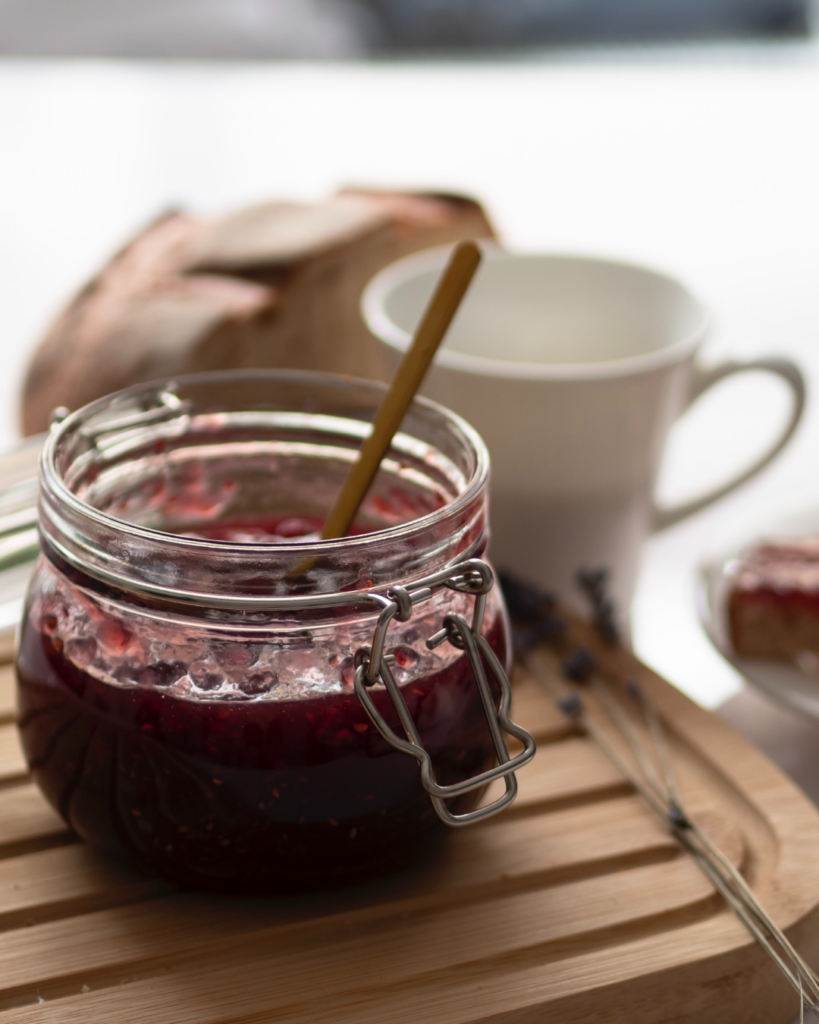
If you like the idea of preserving your own fruit spreads, but you’re confused by the terminology, never fear! Understanding the nuances between various types of fruit spreads–whether it be the difference between jam and jelly, or how to tell what’s a confiture from a conserve–will increase your home cooking and canning expertise. Once you understand the seven basic categories of fruit preserves, you’ll be ready to stock your pantry shelves with delicious flavors to enjoy all year!
Now, you might be wondering if knowing the difference between jam and jelly really even matters. They’re both deliciously sweet fruit spreads that make your toast extra tasty. Does anyone care what they’re called?
The truth is, these terms probably don’t matter much to your belly. But, understanding culinary terminology does matter when you’re trying to communicate with others or searching for a recipe to make something you’re craving.
If you’re speaking to another knowledgeable home canner, a shared vocabulary is not only more efficient, but it helps to be able to know how a food is prepared, the types of flavors to expect, and what ingredients you might need to have on hand.
Plus, it could make a very spicy difference to your tastebuds if you can’t tell a chutney from a marmalade!
For the sake of answering the most fundamental question and filling your trivia knowledge bank, let’s jump right in with the difference between jam and jelly!

Disclosure: This is not a sponsored post, and I have received no compensation for sharing anything that follows. Some links within this blog may be affiliate links, and I might earn a commission if you make a purchase through that link. This usually amounts to cents, not dollars, and helps to support the projects featured on this blog. I only recommend products from companies that I have found to be trustworthy. Read my full disclosure here.

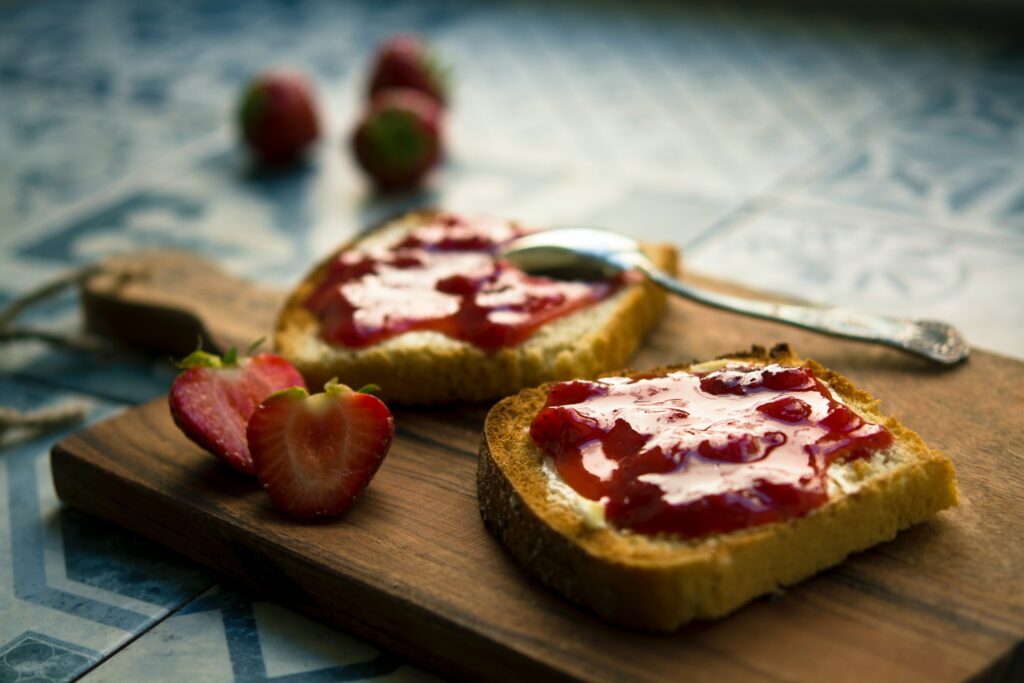
So, what is the difference between jam and jelly?
Simply put, the difference between jam and jelly is that jam contains actual fruit, while jelly is made from fruit juice and contains no fruit.
Where it gets confusing for many folks is the fact that the fruit used to make jam can be so pureed in the production process that you can’t see any fruit bits. This makes the finished product look more like jelly, but nevertheless, they are different fruit spreads.
However, these are not the only two possibilities in the world of fruit spreads! Let’s dive in and discuss all seven major categories, as well as how they are alike and different.
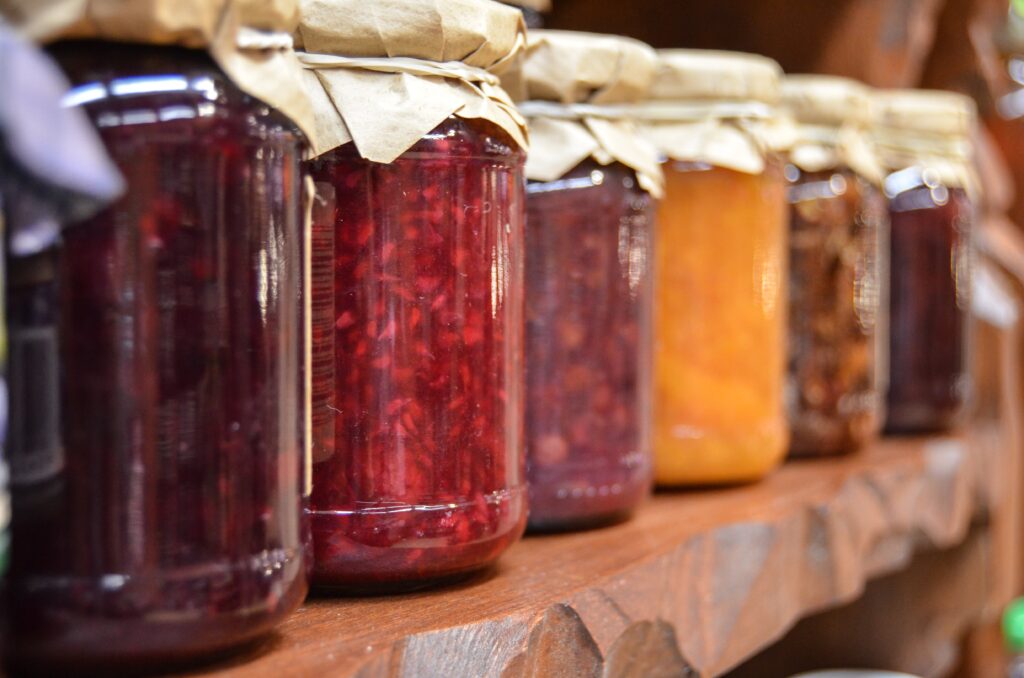
Types of Fruit Spreads
The important thing to understand about soft fruit spreads is that they all share four basic ingredients:
- Fruit: Determines the flavor and color.
- Sugar: Accentuates the flavor and helps to preserve the spread, as well as supporting the gel formation while cooking.
- Pectin: A natural substance found in fruit that causes it to gel when cooked.
- Acid: Naturally occurring in fruit; supports gel formation and adds to the flavor profile.
Now, we can (and must) play with the proportions of these ingredients in various recipes, but all fruit spreads will have these four components in common.
The fundamentals of what makes a fruit spread fit into one category or another that follows, like jam versus jelly, comes down to 1) consistency and 2) cooking technique.
Jam
Jam, the classic favorite, is a thick mixture of crushed or chopped fruit and sugar. With a perfect balance of sweetness and texture, jams can feature a variety of fruit flavors, from the traditional strawberry to more bespoke blends like blueberry-lavender.
In our house, strawberry jam certainly ranks high because it’s such a classic. However, Rob’s longtime favorite is cherry jam. My new love is blueberry jam (recipe on the way soon–be sure to sign up for my newsletter so you don’t miss it!).
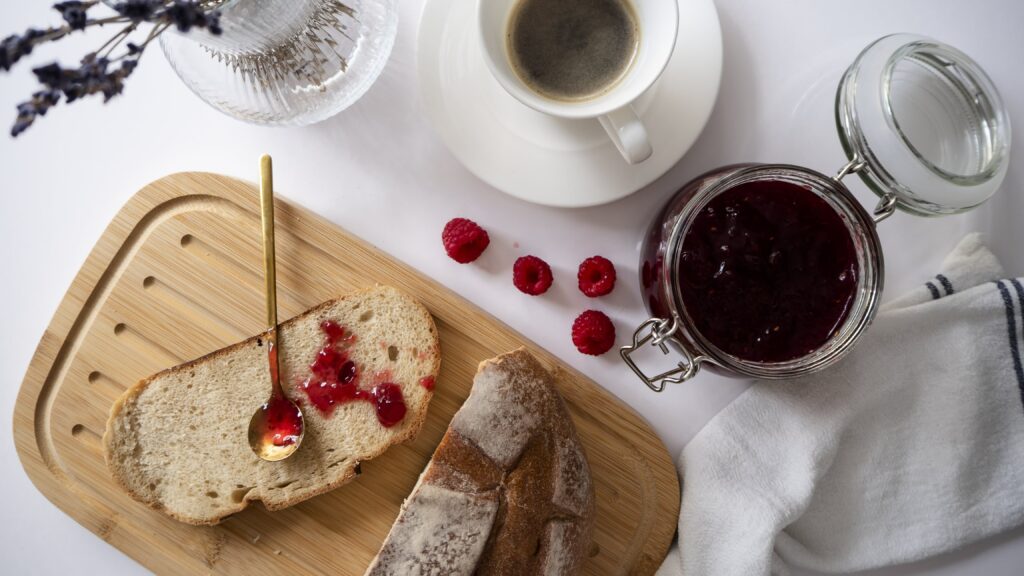
Jelly
Jelly, known for its smooth texture, is made by extracting the juice from fruit and then jelling it with sugar and additional pectin. This results in a more translucent spread that captures the essence of the fruit flavor without any solid pieces, making it ideal for those who prefer a smoother consistency.
That said, you could certainly puree the fruit in your jam a bit more to achieve a smoother finish while still retaining the vitamins and nutrients that come with the whole fruit.
Does jelly contain fruit?
The main difference between jam and jelly is that jam contains real fruit that has been cooked down, while jelly is made only from fruit juice and contains no fruit.
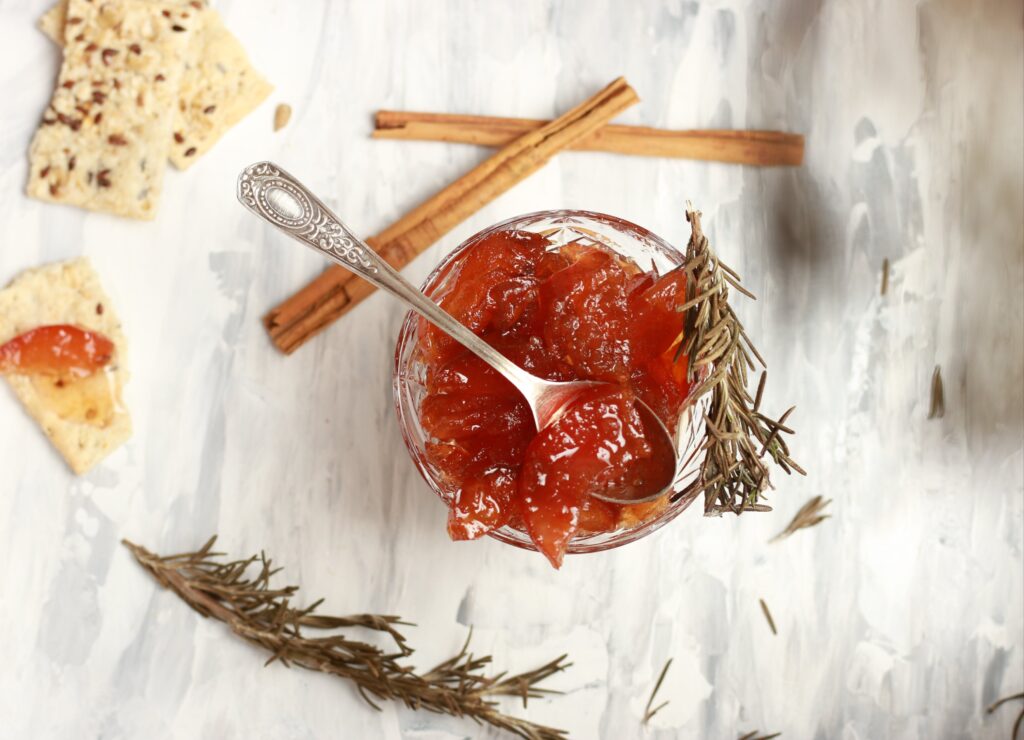
Preserves
Preserves boast a chunkier texture, as they include whole or large pieces of fruit suspended in a sweet, syrupy base. This type of spread is perfect for those who appreciate a more rustic and substantial experience.
Outside of a few jams, preserves (and their cousin, conserves) are what I make the most for our pantry. One of our favorites are my Heritage Plum Preserves which are absolutely delicious in a variety of recipes, as well as on their own!
What is a confiture?
Confiture is the French word for jam, broadly, however the consistency of the finished product is typically more rustic, like preserves, with whole or chopped fruit pieces. The French verb confire means ‘to preserve’.
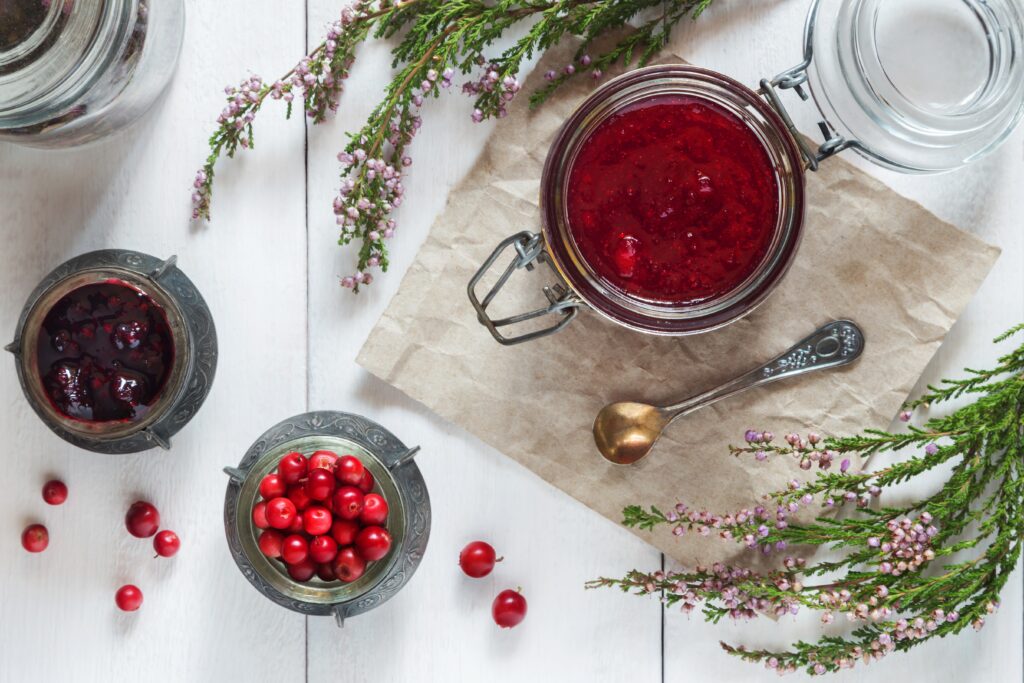
Conserves
Taking it up a notch, conserves are a sophisticated blend of two or more fruits, often including nuts and dried fruits. The complexity of flavors makes conserves a gourmet choice, with unique combinations like apricot-rosemary or fig and walnut.
Last month, I made a several batches of Christmas Conserves to share with friends, family, and neighbors–as well as stock our own shelves! This is a a delicious blend of strawberry, cranberry, and orange with spices that perfectly capture the flavors of the season.
What’s the difference between preserves and conserves?
There are two important differences to note between preserves and conserves. First, when preparing conserves, the fruit is boiled down until it rounds up on the spoon, while preserves contain whole fruit (or large pieces of fruit) suspended in a jelly-like syrup and do not hold their shape. Second, conserves always contain a mixture of two or more types of fruit, and might also include nuts and dried fruit.
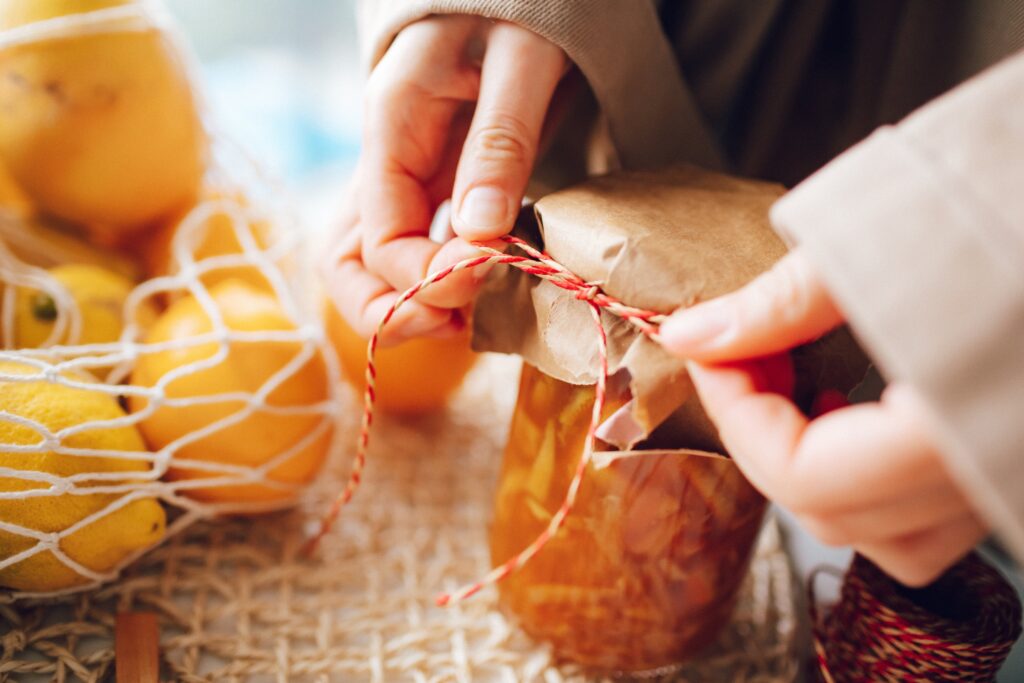
Marmalade
Marmalade, typically citrus-focused, introduces a delightful bitterness from the inclusion of peel. Ranging from the classic orange marmalade to grapefruit or lemon variations, this spread adds a zesty kick to your culinary adventures.
I have to say that marmalade is one I don’t make often. We tend to prefer the sweeter flavors, and the bitterness of marmalade just doesn’t appeal to me as much. It is, however, a favorite for my dad, so I might need to make him a batch at some point this year!
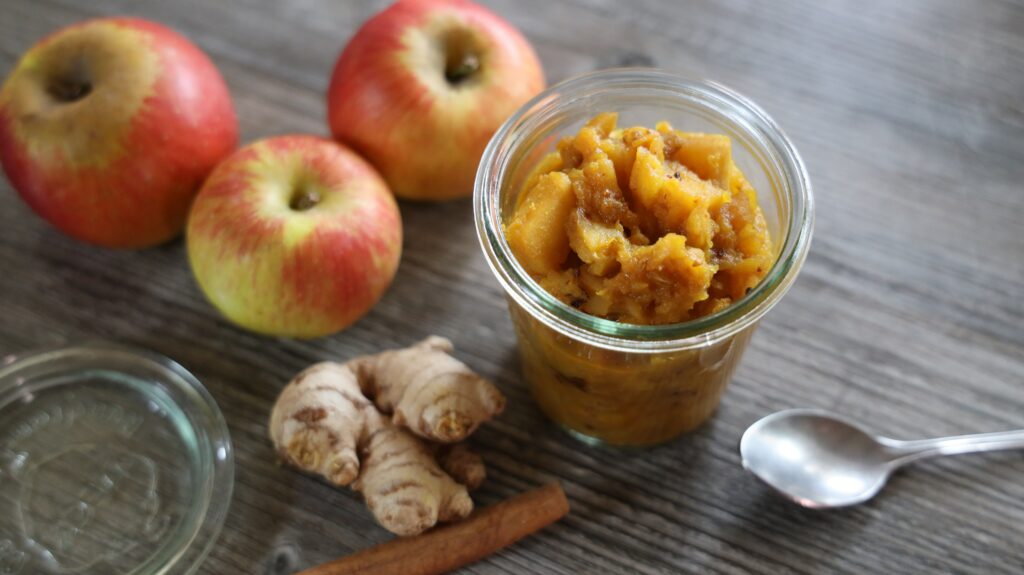
Fruit Butter
Smooth and velvety, fruit butter is achieved through a slow cooking process that gives it a luscious, creamy texture. Often spiced with cinnamon, nutmeg, or cloves, fruit butters go beyond spreading and can be used in baking or as a flavorful addition to sauces.
We always have apple butter stocked on our pantry shelves, and it has been a favorite for me since childhood when I used to love it smeared across a graham cracker. The smooth and sweet spread paired with a rustic boule and a cup of tea makes for the perfect winter snack!
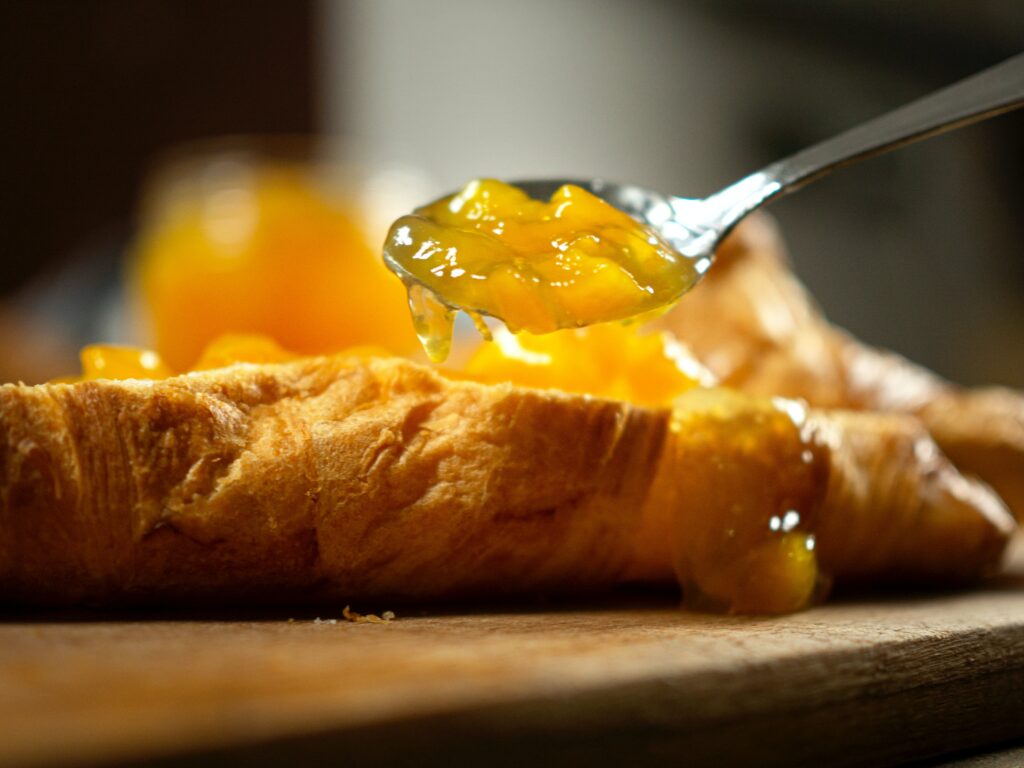
Chutney
Now, chutney is not technically a category of fruit spread because it’s actually a blend of pickled fruit (and often includes vegetables like onions and peppers, too). However, chutneys earn their place in the discussion for their unique combination of chunky fruits, spices, and a savory kick. These spreads are versatile, pairing well with both sweet and savory dishes.
We love to enjoy chutney on sandwiches and burgers, or with South Asian favorites like potato dosas and vegetable pakoras.
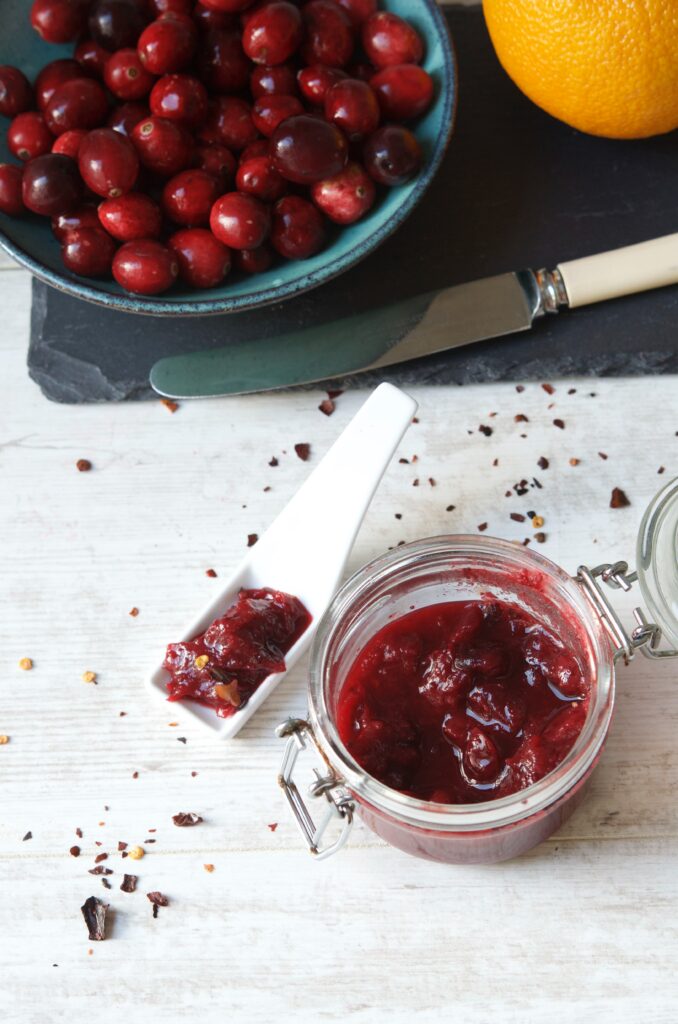
Crafting Homemade Fruit Spreads
Canning and preserving food is about more than just feeding our family. It’s also about preserving our heritage. These are skills that have been passed down through generations, and we believe it’s bigger than food.
Being able to provide for our family makes us less dependent on the supply chain and reduces our impact on the planet.
On average in the US, most produce travels 1,500 miles from where it’s grown to the store where it’s sold. That produce is typically picked and shipped before it has had time to mature, and therefore, has less flavor and fewer nutrients than ripe foods.
And those miles traveled contribute to carbon emissions and greenhouse gases, as well as waste in the form of packaging.
Our homegrown produce travels a matter of feet, and by foot, from the field to our table in just minutes. Preserving our harvests helps to keep us fed and healthy, but also makes us better stewards of the land that we are tasked to protect.
If preserving food is part of your values, learning to can fruit spreads is an excellent place to start! This conversation is certainly much bigger than the difference between jam and jelly, so I will cover more about home canning in greater depth and in a separate post, but for now, let’s review the basics as they pertain to fruit spreads.
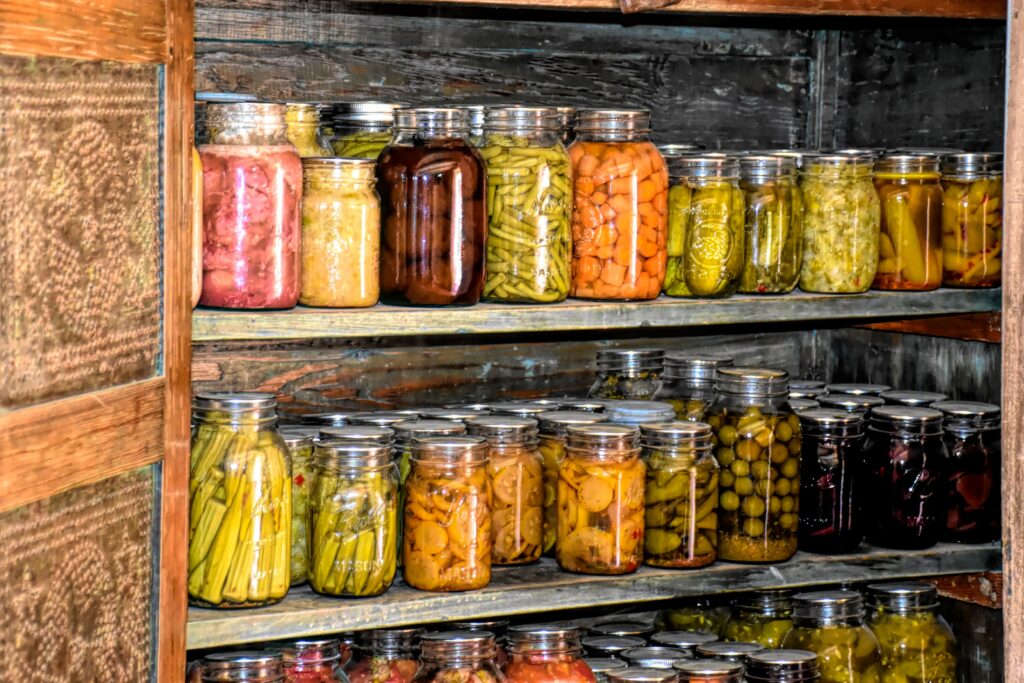
Canning Basics
Because fruit spreads are a high-acid food, you are able to preserve them with much more ease. A boiling-water method of canning is sufficient to destroy molds, enzymes, and yeasts that would be a problem for food safety in other types of preserved foods.
The boiling-water method is not, however, sufficient to destroy some types of bacteria. Those bacteria thrive in low-acid situations, and they aren’t destroyed until temperatures reach 240°F/115.6°C. That temperature is higher than can be achieved by boiling water, and so a pressure canner is needed in those situations.
However, the high-acid environment of fruit spreads and pickles mean that you don’t need to fear this issue, and it makes home canning that much easier when you’re just starting out.
Understanding Sterilization
Before you begin canning your fruit spread, you must sterilize your jars. We do this in our dishwasher because it has a “sterilized” setting. The jars are the only thing in the washer, and I set it to run a heated drying cycle when complete, which helps to keep the jars warm enough for filling.
Alternatively, you can hand-wash your jars, then submerge them in simmering water (180°F/82.2°C) for 10 minutes before filling.
Your lids will go into a small sauce pan with water and simmer, as well. Do not allow them to boil! Remove the lids from the simmering water one at a time as you are ready to close the filled jars.
These steps will ensure that your jars stay clean and prevent the spread of bacteria and other contaminants.
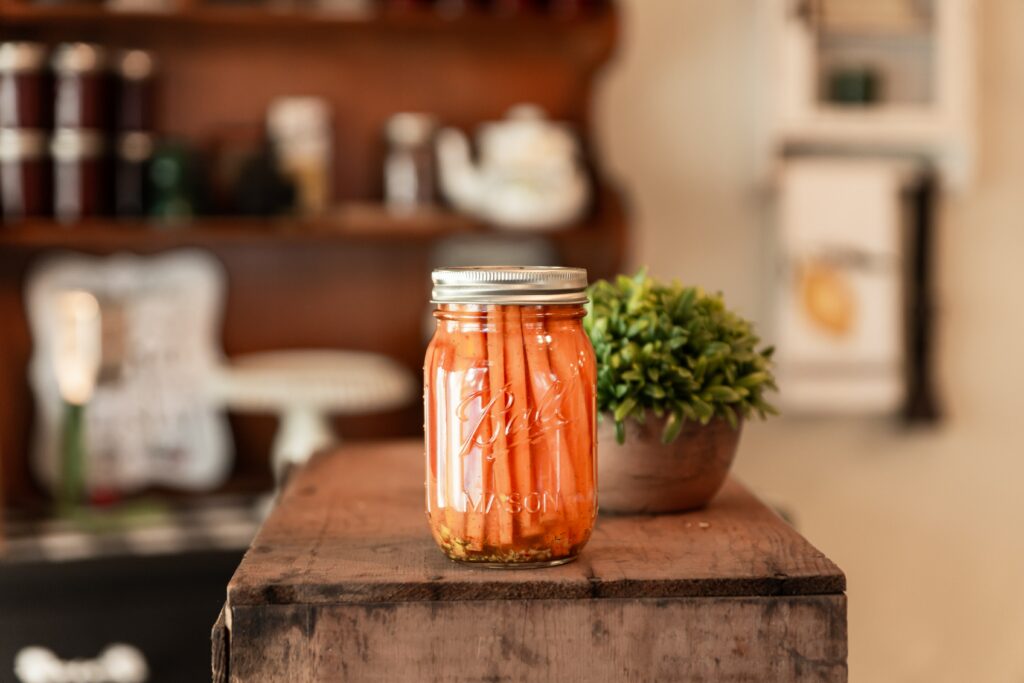
Ensuring a Proper Seal
Before putting lids onto filled jars, make certain to wipe the rims with a clean, damp cloth. If you miss any debris, it can cause your seal to fail.
Using a lid wand, lift the lids from the simmering water and place them onto the jar so that the sealing compound is in perfect contact with the glass.
Next, screw on the metal band to hold the lid in place during the canning process.
After the jars have been processed, you’ll leave the bands on the jars and make sure the jars are completely undisturbed for 24 hours. This means–no picking them up to look at them or test the seals. Just let them rest.
After 24 hours, it’s time to press the center of the lid to check for a proper seal. If the lid pops, you will need to put that jar into the fridge for immediate consumption.
This is also the time when you can remove the metal bands. Because the lids are vacuum sealed, the band is now unnecessary. The bands also make it more difficult to tell if a lid’s seal fails in your pantry, so it’s a good idea to remove them when storing your finished jars.
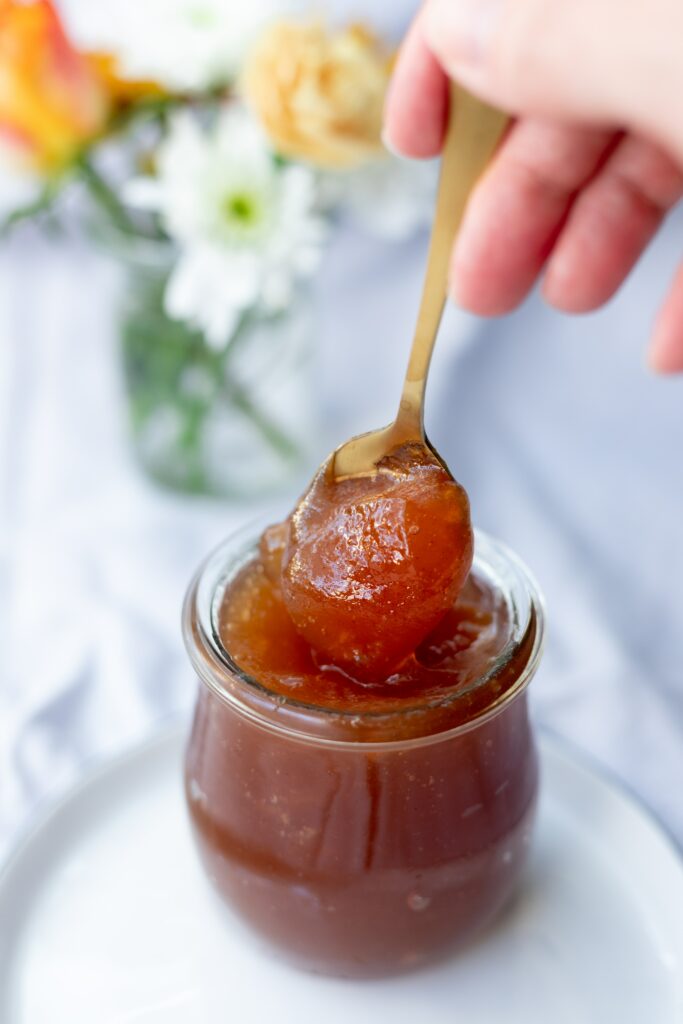
Equipment
Canning soft spreads requires fewer tools than preserving other types of food. You will only need the following to begin:
- Boiling-Water Canner: Make sure to choose a canner that is deep enough for the water to cover your jars by 1 to 2 inches. This one is the perfect choice for preserving all of your high-acid foods like fruit spreads and pickles. If you think you might eventually like to preserve other foods, like vegetables, meats, and soups, it’s worth considering the purchase of a pressure canner which you can also use as a boiling-water canner. This gives you more flexibility in the future without having to make another purchase later. This is the canner we have in our home.
- Jars, Lids, and Rings: Jars and rings are reusable so long as they remain undamaged, however the lids are single-use. The reason for this is that the sealing compound around the rim of the lid is compromised after the first vacuum seal. Attempting to reuse them later is risky, and they are so inexpensive that it’s not worth the chance of becoming seriously ill or having to throw away spoiled food that you worked so hard to put up.
We use Ball mason jars and lids for 99.9% of all canning on our farm. However, I recently invested in these very charming French jars that are the perfect size for fruit spreads. While they are much more expensive than the basic half-pints you can purchase in bulk, they are so beautiful on the table and perfect for special occasions or gift-giving. - Canning Utensils: At very minimum, you will need a funnel, jar lifter, and lid wand. I recommend (and personally use) this complete set of canning utensils because it gives you everything you need.
I will tell you right now that there are many, many other gadgets and neat things on the market that can enhance your home canning experience, however the list above is all you NEED to get going.
Other helpful items that you might consider adding in the future include:
- food scale,
- jar labels,
- plastic storage caps,
- cherry pitter,
- citrus zester,
- apple corer/peeler,
- candy thermometer,
- jelly bag, and,
- pectin.
That last item–pectin–is something we must address separately when we’re talking about fruit spreads.
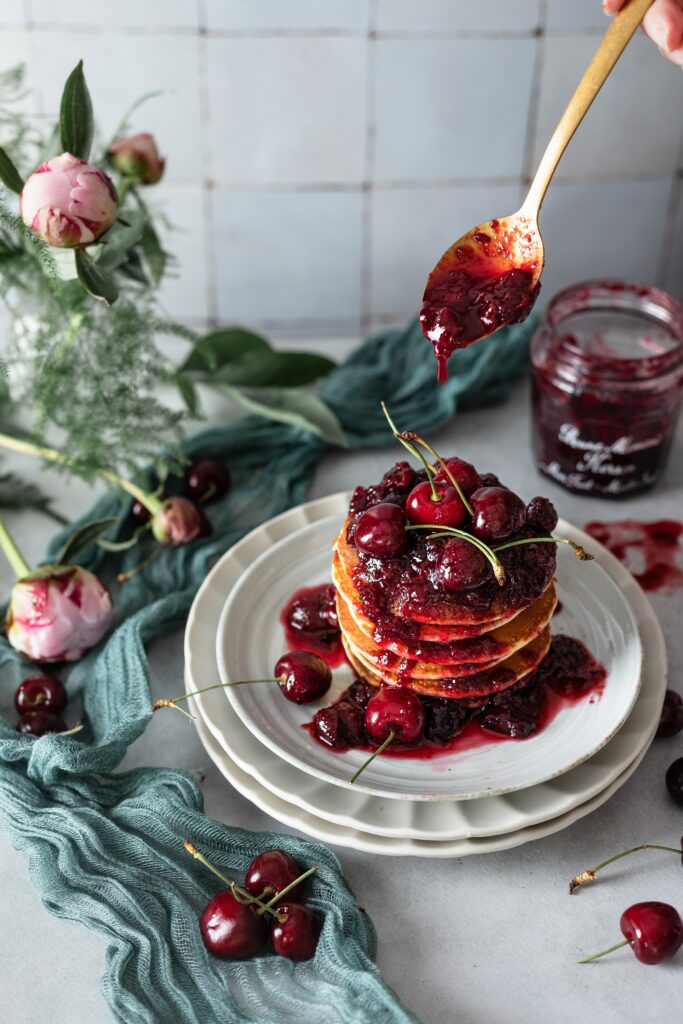
The Role of Pectin in Fruit Preserves
When thinking about the difference between jam and jelly (and any other fruit spread, for that matter), we do need to look at the issue of pectin. This topic is a bit controversial, and pectin gets a bad rap through the canning community. Let’s discuss what all the fuss is about…
What is Pectin?
Pectin is a naturally occurring substance in the cell walls of plants. It’s a soluble fiber that helps to thicken foods, and that’s why it’s essential to the jelling process of fruit spreads.
Is pectin bad for you?
The very basic answer is no, pectin is not bad for you in simple terms. In fact, because it’s a soluble fiber, it can help to control high cholesterol, triglycerides, and to prevent colon cancer.
That said, pectin is a complex starch that functions as a thickening agent. Inside your body, pectin binds substances together and adds bulk to your stool. (Now there’s something I never though I would be blogging about…and yet, here we are…)
If you consume enough of anything, there are going to be undesirable effects. The same is true with pectin. Some people are more sensitive to pectin and find that it can cause them some gastrointestinal upset, especially when eating too much of it.
Is pectin required to make preserves?
Again, let’s start with the short answer: Yes, pectin is required to make fruit spreads.
Now, let’s dig a little deeper.
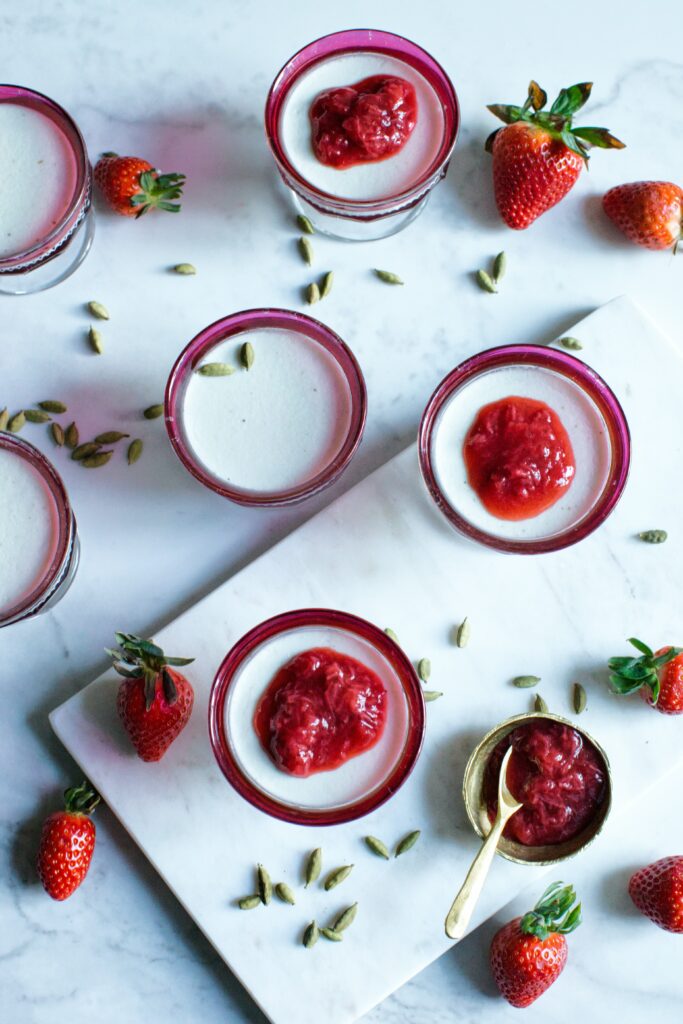
Like I explained above, pectin is naturally occurring in plants. Some fruits have more or less of it than others. Citrus fruits, apples, cranberries and grapes are all very high in pectin. Strawberries and pears, however, are low in pectin. That’s what makes it more difficult for them to reach a good jelling point for preserves.
In those cases, you can add pectin to the recipe to achieve the desired result. This is the fastest and easiest solution.
But, let’s say you aren’t keen on the idea of adding pectin in the powdered form, or maybe you’ve discovered that you’ve run out while your fruit is cooking. You do have other options…
Are there pectin substitutes?
Yes, there are several options for substituting pectin. One of the easiest is to zest the peel of a citrus fruit (like an orange or lemon). The natural pectin in the peel will do the trick–especially the white part which is full of pectin.
There are also other thickening agents you might want to consider such as cornstarch and carrageenan. However, some people object to adding these to their foods for various ethical and/or health reasons.
And finally, you can also add more sugar and cook the fruit longer to achieve thickening without adding pectin. This might be a good option if you are particularly sensitive to pectin.
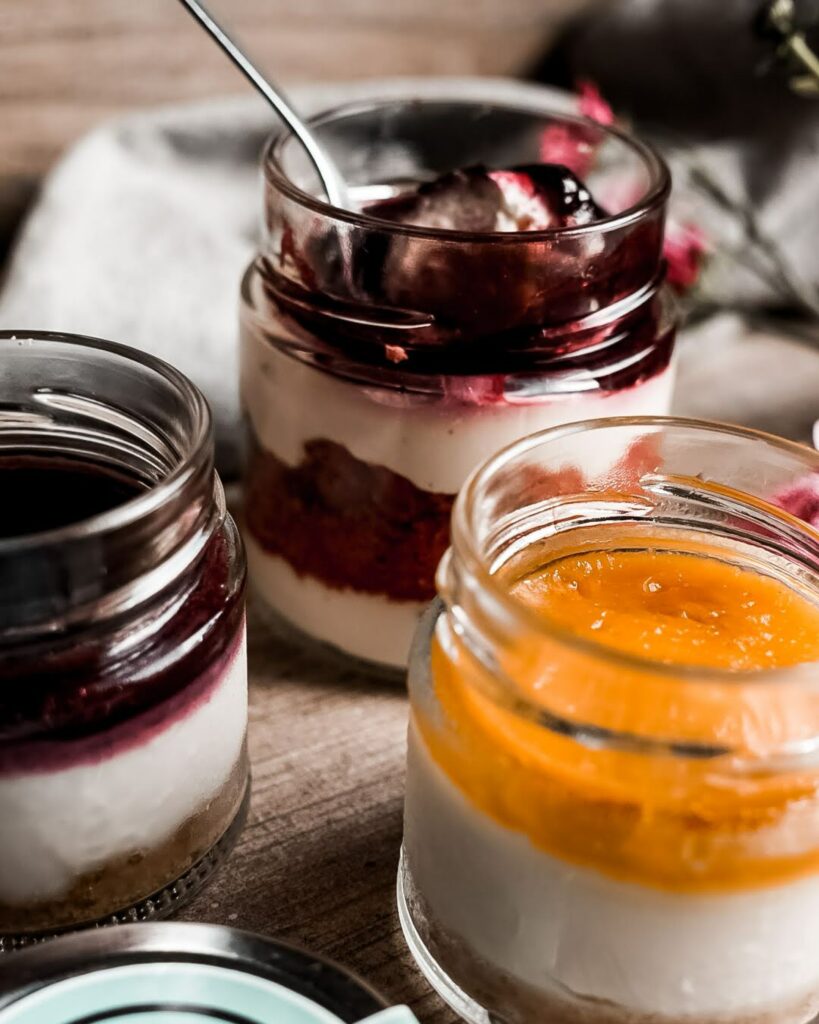
A Sweet Dilemma
The question of how much sugar to add to your fruit spreads is a complicated issue. As you’ve learned from everything we’ve already discussed, there is an important balancing point between the variables of making preserves: pectin, sugar, acid, cooking time, and your choice of fruit(s).
If refined sugar consumption is something you want to reduce, then, here again, there is more of a difference between jam and jelly to consider.
Generally speaking, if you want to make fruit spreads that are lower in sugar, then you’ll need to use higher amounts of pectin to achieve proper jelling. Although you do have some wiggle room, depending upon how long you cook your fruit, as well.
As you gain more practice, you’ll start to become a home canning scientist in your own right. Tinkering with recipes will be a joy and allow you to customize your creations to your liking. Inventing your own “secret family recipes” is certainly part of the fun of making preserves!
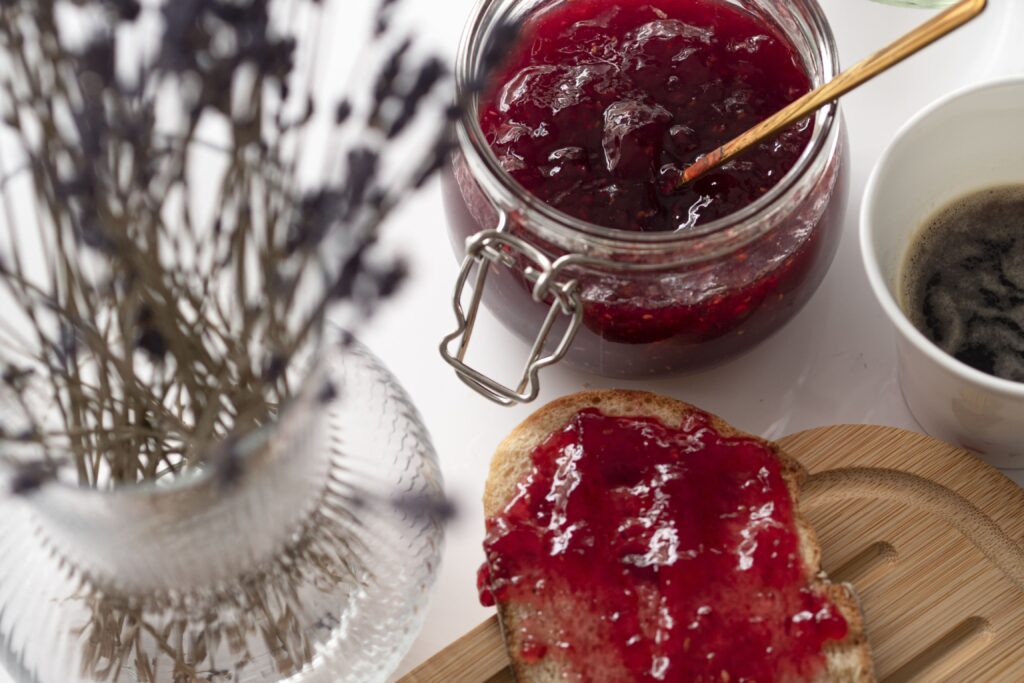
Shelf-Life Considerations
Home-canned goods are safe to eat for one full year, so long as you’ve followed all proper methods of canning and storage. There is no difference between jam and jelly (or any other preserved food). You will be able to stock your pantry for a full year. After that year is when things will start to deteriorate in quality.
Does that mean you can’t eat home-canned items after one year? Technically, no. You can still eat them, but be prepared that they might not look or taste quite as good. And as time goes on, it becomes more and more iffy.
It’s really a good idea to make sure you consume all home-canned items within no more than two years. In our home, we target 18 months, although this is rarely an issue because we preserve only what we need. If we ever do end up with food that’s getting too close to the 18-month window, we always share it with friends and family. That ensures it doesn’t go to waste.
And speaking of ways to use up your home-canned fruit spreads, there are a number of ways to accomplish this tasty task outside of the breakfast hour!
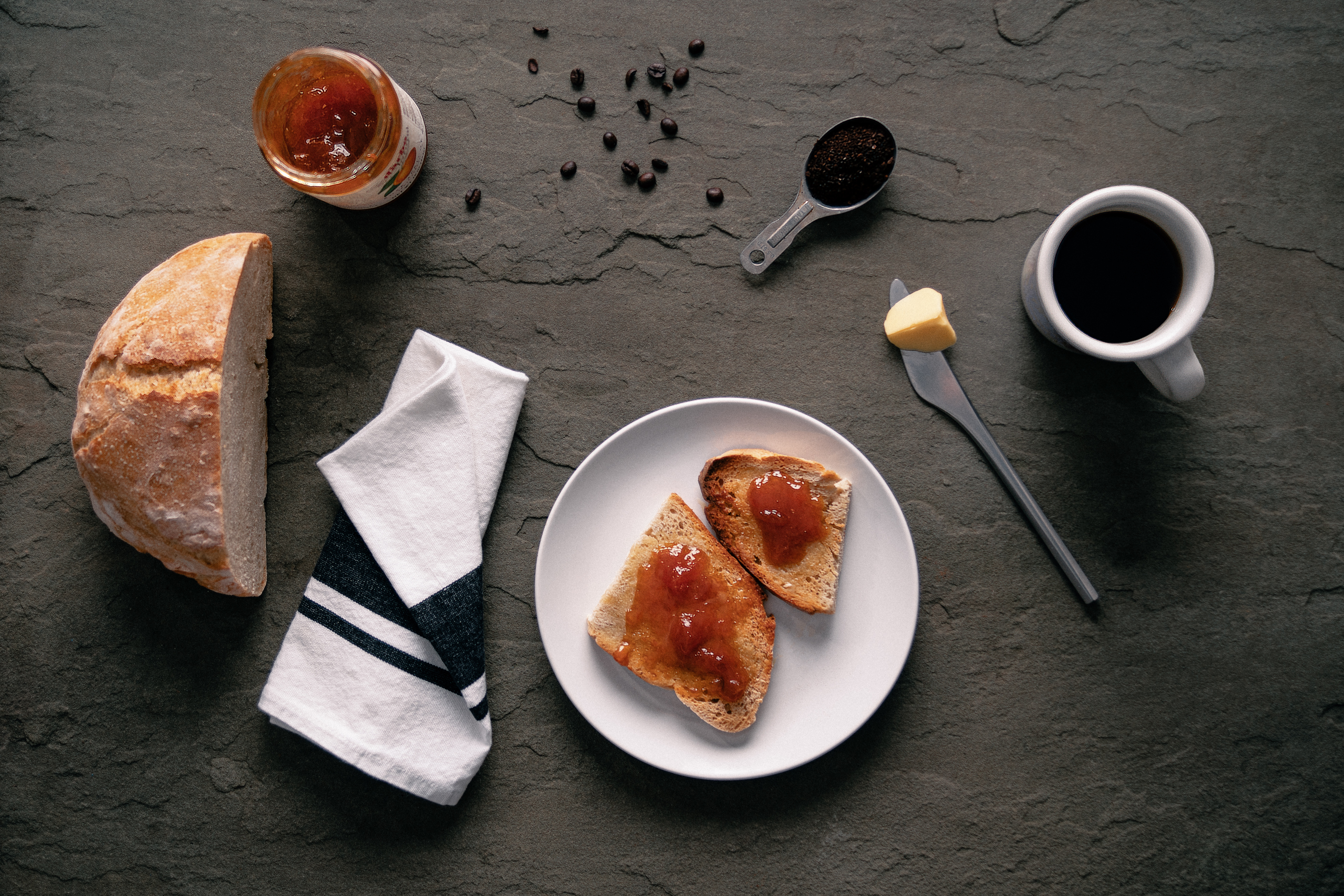
Beyond Breakfast Toast: 10 Creative Uses for Fruit Spreads
There are so many ways to enjoy fruit spreads, and breakfast is only one slice of the pie. In fact, as you start exploring more ways to use your fruit spreads, you might need to double or triple your home-canning activities!
Consider these delicious ideas and increase your enjoyment of your home-canned preserves:
- Sandwich Spread
Use your favorite preserved fruits as a sandwich spread. The difference between jam and jelly (and other fruit spreads) is all about personal preference while you experiment with different flavor combinations. Try using cranberry preserves around the holidays, or add a spicy chutney to your grilled cheese! - Stuffed French Toast
Before dunking, smear a layer of lightly sweetened cream cheese topped with your favorite fruit spread between two pieces of bread for a next-level brunch. - Mix Into Oatmeal
Whether you cook your oats on the stovetop, or enjoy overnight oats from the fridge, a dollop of fruit spread sweetens the experience! - Ice Cream Topping
Try warming up a couple of tablespoons of your favorite fruit spread to drizzle atop a bowl of ice cream. - Serve With Crackers and Cream Cheese
One of our favorite appetizers for game days and movie nights is Kite Hill Cream Cheese that we top with fruit spread. We change up the flavors depending on our mood, but it’s always delicious atop a crunchy almond flour cracker. Or, try it with baked crostini. Yum! - Salad Dressing
Make an easy vinaigrette by mixing a half pint jar of your favorite fruit spread with one cup of olive oil, one tablespoon each of white wine vinegar and lemon juice, and salt and pepper to your taste. If you prefer a sweeter dressing, you can add up to 1/4 cup of maple syrup. I suggest adding just one tablespoon at a time. Store leftovers in the fridge for up to a week. - Glaze or Marinade
You can create a simple, but extraordinary marinade in no time with your canned fruit spreads. Combine equal parts fruit spread, maple syrup, and apple cider vinegar with salt and pepper to your liking. If you like a little spice, add a pinch of crushed pepper flakes, too! - Thumbprint Cookies
You can make thumbprint cookies by pressing an indentation into your favorite sugar cookie dough before baking, then filling with a dollop of fruit spread. A must-have for the holiday cookie tray! - BBQ Dipping Sauce
We love to make custom BBQ dipping sauces for hot sandwiches, potato wedges, and even plant-based meatballs over cauli-rice! The difference between jam and jelly is irrelevant here, and we use both depending on the consistency we desire. Simply combine equal parts of your homemade fruit spread with your favorite brand of BBQ sauce. We like this one because it’s gluten-free. The combinations are endless! - Bake Into Muffins
Level-up your muffins with a sweet surprise! Using any of your favorite muffin recipes, fill the paper cup 1/3 full. Then drop 1-2 tsp of fruit spread in, and top with remaining batter before baking as normal. I do find that there’s a bit of a difference between jam and jelly when added to muffins, and I prefer to use chunkier preserves in baked goods. Jelly tends to melt into more of a syrup when baking and loses its wow factor.
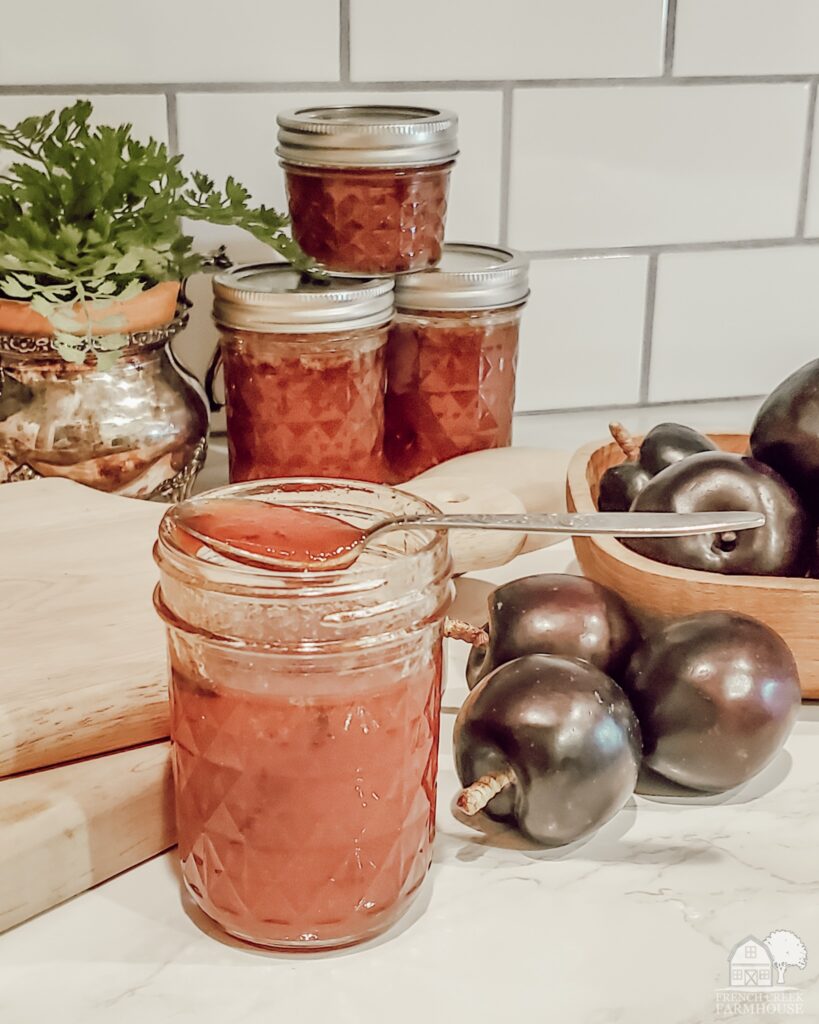
Fruit Preserves Are About So Much More Than Delicious Food
Having access to good food that you grew and cooked yourself is reason enough to start preserving your own fruit spreads. Knowing exactly what you’re eating and where it came from is important to health and well-being, for sure.
Yet, beyond that, I think there’s a great importance in learning how to provide for ourselves.
Only a couple of generations ago, these were common skills that were necessary for day-to-day living. But our world has become busy and fast. Almost no one has the time or care to slow down and acquire the knowledge that’s foundational to our heritage.
I believe that’s a great pity because when we lose this knowledge, we lose touch with our roots. We no longer understand from where and who we came. A part of us withers and is soon forgotten, all in the name of progress.
These days, maybe it doesn’t really matter if anyone knows the difference between jam and jelly. Maybe it’s just food to be consumed quickly and on-the-go, and how it’s made is simply trivia.
Without a doubt, time marches on, and people will continue to evolve. But, for our family at least, I see that we live better when we are grounded in meaningful work, invested in knowing how to do things for ourselves, and have more freedoms because of it.

Looking for some delicious and easy ideas for dinner?
Get my free grain bowl recipe guide
Let’s be email pen pals! Sign up to join our community, and get your free printable PDF Grain Bowl Recipe Guide. This is so good!

